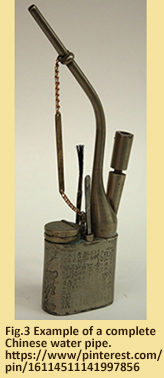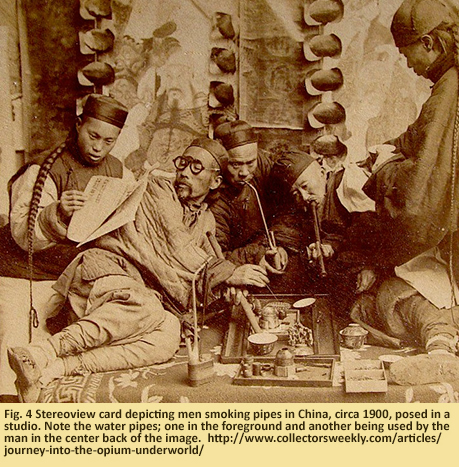Smoking in Life and in the Hereafter:
A Chinese Water Pipe from Deadwood, SD
May 2015
By Francis Lukezic, Conservator, MAC Lab
From 2001 to 2004, the City of Deadwood carried out extensive archaeological excavations within a part of the city that was once home to Chinese immigrants during the late 19th and early 20th centuries. One of the more unusual artifacts discovered during the Chinatown excavations was a copper alloy metal Chinese water pipe, which was sent to the MAC Lab for conservation (Figure 1).

This type of pipe was used for smoking tobacco, opium, or a mix of the two (Leatherman 2007; Wylie and Fike 1993; Kennedy 1969). Although the pipe is currently in several pieces and soil and corrosion products partially obscure the surface, the object is actually quite decorative. The surface of the pipe’s box is adorned with an elaborate scene containing plants and the figure of a Chinese woman (Figure 2). The scene is framed by bands of floral patterns, with the uppermost band retaining a partially gilded surface. Figure 3 is an example of a Chinese water pipe that is similar in shape and style to the one from the Deadwood Chinatown excavations and provides an overall view of how the pipe pieces would have been assembled during its working life.

 The ornate water pipe was discovered at the lowermost level of a small pit, wrapped in a black colored Chinese vest with a brown fabric lining, with most components removed from the box and the pieces dented or damaged. There was also a bundle of two shirts, one black and one made of brown fabric. The vest and the black shirt have cut marks in the fabric. A second Chinese water pipe with no decoration, ceramic opium pipe bowl fragments, and fragments of an opium pipe smoking kit (glass lamp, metal tray, wood needle) were also located within or on top of the bundle of clothing. In this same layer of the pit, the wall was lined with partially burnt wood fragments and contained seeds from several types of fruit (such as watermelon, cherry, grape, plum, blackberries, raspberries), animal bones (cow, pig, sheep, chicken, turkey), two Chinese coins, and over 100 used matches.
The ornate water pipe was discovered at the lowermost level of a small pit, wrapped in a black colored Chinese vest with a brown fabric lining, with most components removed from the box and the pieces dented or damaged. There was also a bundle of two shirts, one black and one made of brown fabric. The vest and the black shirt have cut marks in the fabric. A second Chinese water pipe with no decoration, ceramic opium pipe bowl fragments, and fragments of an opium pipe smoking kit (glass lamp, metal tray, wood needle) were also located within or on top of the bundle of clothing. In this same layer of the pit, the wall was lined with partially burnt wood fragments and contained seeds from several types of fruit (such as watermelon, cherry, grape, plum, blackberries, raspberries), animal bones (cow, pig, sheep, chicken, turkey), two Chinese coins, and over 100 used matches.
 During the excavation of Deadwood’s Chinatown, only two Chinese water pipes were found, implying they were greatly valued and likely belonged to an individual of high status (Leatherman 2007). But the significance of the water pipe increases even more when taken into account with the other artifacts and material found in the pit. This pit was identified as a ceremonial feature for a Chinese funerary ritual called the Shao Yi, or burning of the clothes (Leatherman 2007). The Shao Yi is performed by the family shortly after the individual dies to “symbolically feed the spirit, eliminate sources of death pollution, and transfer the spiritual essence of the deceased’s possessions to the afterlife” (Leatherman 2007: 35). In the ritual, the deceased’s personal belongings are deliberately damaged, placed in a small pit, and then burned. Food offerings are also placed in the pit to feed the deceased individual on their journey to the hereafter. The overall contents of the pit, with evidence of fire, presence of food items, and intentional damage to objects, are consistent with the unique Shao Yi ritual (Leatherman 2007).
During the excavation of Deadwood’s Chinatown, only two Chinese water pipes were found, implying they were greatly valued and likely belonged to an individual of high status (Leatherman 2007). But the significance of the water pipe increases even more when taken into account with the other artifacts and material found in the pit. This pit was identified as a ceremonial feature for a Chinese funerary ritual called the Shao Yi, or burning of the clothes (Leatherman 2007). The Shao Yi is performed by the family shortly after the individual dies to “symbolically feed the spirit, eliminate sources of death pollution, and transfer the spiritual essence of the deceased’s possessions to the afterlife” (Leatherman 2007: 35). In the ritual, the deceased’s personal belongings are deliberately damaged, placed in a small pit, and then burned. Food offerings are also placed in the pit to feed the deceased individual on their journey to the hereafter. The overall contents of the pit, with evidence of fire, presence of food items, and intentional damage to objects, are consistent with the unique Shao Yi ritual (Leatherman 2007).
As a result, the Chinese water pipe is not only a status symbol out on the western frontier, it physically demonstrates that the Chinese immigrants were engaging in traditional ceremonies from their homeland. The ancient Egyptian nobility were not the only people that wanted to have their possessions available to them in the afterlife.
| References |
|
| Kennedy, Charles E. |
| 1969 |
Chinese pipes for tobacco and opium. Antiques, Vol. XCV, No. 3. |
|
| Leatherman, Christopher |
| 2007. |
Web resource:Chinese Mortuary Rituals in Deadwood, SD: An Archaeological Perspective. M.A. thesis, University of South Dakota. |
|
| South Dakota State Historical Society |
| 2008 |
Deadwood Chinatown Excavation Site Report. South Dakota State Historical Society Archaeological Research Center. |
|
| Wylie, Jerry and Fike, Richard |
| 1993 |
Chinese Opium Smoking Techniques and Paraphernalia. Hidden Heritage: Historical Archaeology of the Overseas Chinese. Amityville: Baywood Publishing Company. |
|